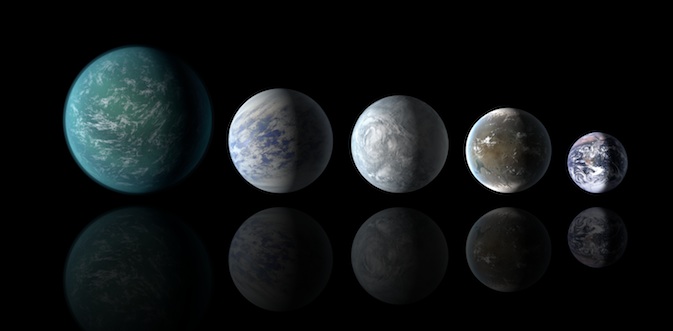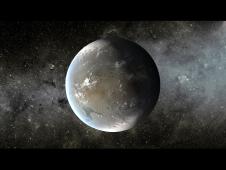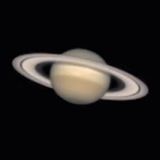
As the number of known Earth-like planets in "habitable-zones" outside of our solar system increases, the chance of life being unique to earth grows ever smaller.
By David Jay Brown

Relative sizes of all of the habitable-zone planets discovered to date alongside Earth. Left to right: Kepler-22b, Kepler-69c, Kepler-62e, Kepler-62f and Earth (except for Earth, these are artists' renditions). Image credit: NASA Ames/JPL-Caltech
When I was in college, my psychobiology professor told me that he was convinced that there was no intelligent life beyond our planet and that we were alone in the universe.
"Where are they?" he asked and laughed, not acknowledging any of the sensible explanations that could help to account for why our species hasn't yet discovered extraterrestrial life.
In the 1980s, when my professor made that arrogant comment about extraterrestrial life, there had yet to be another planet discovered outside of our own solar system-let alone one that might be able to sustain organic life, and where intelligent organisms might evolve.
Although long suspected by astronomers, it's only in recent years that planets outside of our solar system (known as "exoplanets") have been confirmed to exist. The first detection only came in 1992, two years after the launching of the Hubble Space Telescope.
Since then, astrophysicists have been scouring the universe, searching for exoplanets with life-sustaining properties like earth—where there is a similar chemical composition, and a temperature range where the water can easily convert from solid, to liquid, to gas.
Liquid water appears necessary for the evolution of life, and water is only a liquid at a very narrow temperature range.
Today we now know that many of these extrasolar "habitable zone" planets, (or "Goldilocks Zone" planets, as they are sometimes called) where it is possible for liquid water to exist-can be found throughout our galaxy alone.
For a little perspective, our galaxy consists of around 200 billion stars, and some galaxies consist of hundreds of trillions of stars.
After you digest those figures, then consider that there are 100 billion galaxies in the observable universe.
A recent collaborative analysis by the Institute of Astrophysics in Paris, the European Southern Observatory, and others, suggested that every star in the universe is orbited by at least one companion planet.
According to astrophysicist Jean Schneider at the Paris Observatory, who regularly updates the Extrasolar Planets Encyclopedia website, as of May 3, 2013, 884 exoplanets have been discovered.
In his book Exoplanets and Alien Solar Systems, astrophysicist Tahir Yaqoob, says that what actually defines a "habitable zone" is open to debate.
However, a general consensus among astrophysicists is that between 2.4 percent and 4.5 percent of exoplanets discovered spend more than 90 percent of their time within "habitable zone" boundaries.

Relative sizes of all of the habitable-zone planets discovered to date alongside Earth. Left to right: Kepler-22b, Kepler-69c, Kepler-62e, Kepler-62f and Earth (except for Earth, these are artists' renditions). Image credit: NASA Ames/JPL-Caltech
On April 28th, NASA announced that the Kepler space mission had discovered two new planetary systems, which include three "super-Earth-size planets" in the "habitable zone," including the smallest of the "habitable zone" planets discovered to date.
The small, newly discovered "habitable zone" exoplanet—known as "Kepler-62f"—orbits a star smaller and cooler than our sun every 267 days, and it is only 40 percent larger than Earth, making it the exoplanet closest in size to our own world.
It seems likely that more "habitable zone" planets will soon be discovered, and this means that life may exist all over the universe.
Indeed, some biologists suspect that life is an integral part of the universe, and that the universe itself may be alive in some sense.
Stars are known to eject massive amounts of water, which spray onto the surface of their orbiting planets.
Amino acid chains—the building blocks of genetic material, which encode for biological design—have been found inside of comets, and many biologists now believe that a comet crashing into the primitive oceans of earth, is how life began on our planet.
This may be how life begins over the universe, with comets splashing into the oceans of fertile worlds, like sperm fertilizing eggs on a cosmic scale.
The universe may be teeming with life, and our little blue world may not be as unique as it seems at first.
Something to think about when we look up at the stars.
David Jay Brown is an award-winning science writer, whose work has appeared in Scientific American, Scientific American Mind, and Discover magazines. He is the author of 11 books about the evolution of consciousness, optimal health, and the future.

















